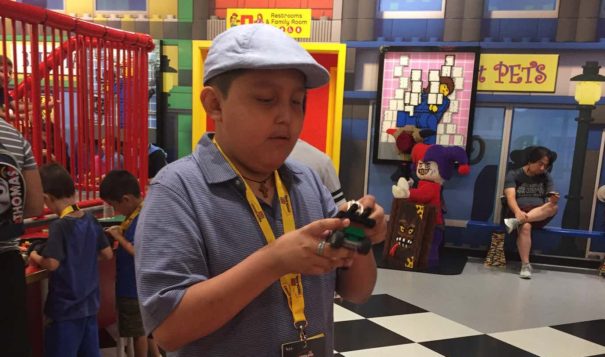
Dene youth to attend a space camp in Alabama after saving for two years
Delaney Kilgour, Dene, and his mom are driving more than 3,500 miles from Alberta, Canada, to Alabama in less than a week to attend two NASA-inspired camps at the end of the month.
The 12-year-old was accepted to the aviation challenge and space camp robotics in December by the U.S. Space & Rocket Center. The center is the official visitor center for NASA’s Marshall Space Flight Center where the public can be immersed in astronaut, jet, pilot, and engineering experiences.
“I was pretty happy and excited and kind of cried,” he said when he found out he was accepted in December.
He loves to tinker with legos.
Kilgour has been playing with legos since he was a toddler, said Karen Young, his mother. The pieces were large back then and they just got smaller from there.
He builds with his two close friends. One of them comes from an hour away.
“They constantly build. They’re always building. It’s like minecraft,” she said.
Kilgour has a knack for building masterpieces, especially with motors.
Niagara Falls, London Bridge, Big Ben Tower, Taj Mahal, Pentagon, and big ships.
He hasn’t been to these places, but he can build them using pictures.

Since the big lego kits cost approximately $400 to $600 at the lego store, they would take a picture of the cover and Kilgour started building at home.
His next project falls inline with his summer camp: building a rocket as tall as a lamp or a kitchen cabinet. (But with actual legos and not with toilet paper rolls like he and his grandpa used to do.)
The 7th grader found out about the camp at the engineering and robotics summer camp at the University of Toronto in 2017. The instructors talked about this NASA-inspired summer camp.
“My parents said that it is expensive and that I would have to help to pay for the tuition,” he wrote in a January letter. “I don’t think my mom and dad believed me that I was so serious.”
Both camps cost $999 each which totaled approximately $2,000. It covers the program, housing and all meals for the student. It does not cover transportation. Parents are responsible for their own accommodations.
Kilgour saved $2.50 each time he supervised kindergarteners and 1st graders during recess at school. He babysat cats and dogs, and collected bottles.
By the time the tuition was due in December Kilgour saved $2,800. He was guaranteed a seat for both programs from July 28 to August 10.
“It is a big experience and we’re really excited,” Young said.
Kilgour said he “kind of” likes. But he’s more interested in building a robotic legs and arms that can grab something or walk. It could find new things on planets or a new species.

His mom was excited to learn that NASA engineer Aaron Yazzie, Navajo, does similar work that Kilgour hopes to do in the future.
Yazzie, who works at the NASA Jet Propulsion Laboratory in Pasadena, California, built a pressure inlet that was part of the spacecraft that landed on Mars in November.
He had some words of wisdom to Kilgour.
“Aww that’s so good to hear! I’m very proud of him!” said Yazzie before boarding a flight to Spain. “I started attending summer programs and STEM programs when I was a young student too – he’s totally on the right path.”
Yazzie also identifies with Kilgour on maybe being the only one or a handful of Indigenous students in STEM-related programs.
The U.S. Space & Rocket Center doesn’t track students by ethnicity but they did confirm they have had other Indigenous students come through the program, said Pat Ammons, director of communications.
Representation is still a concern for Indigenous youth in any field, but Yazzie learned from those experiences.
“It really teaches you how to be a leader and representative for your people,” Yazzie said. “It also reveals to you that, even though you come from a community that hasn’t always been able to participate in programs like this, you have just as much ability as any of them to follow this dream.”
Young said her son often says, “If you can dream it, you can do it.”
One of his dreams is to build his aunt a lighter robotic foot.
Kilgour’s aunt Eileen, 64, lost her foot to diabetes a year and a half ago. She suffered during the winter from cramps and the cold. Her now robotic leg would feel heavy too.
Young remembers one time where Kilgour lifted up her leg when it cramped and said, “Well, auntie, I’m going to make you a foot. It’s going to be lighter.”
His third goal he mentioned on the phone from Alberta was to build a hearing aid. Not like the ones today. But one that looks like an ear.
He’s very considerate, his mom said.
Even though this is a once-in-a-lifetime opportunity, he still has his friends in mind.
His mom asked him, “What does he want to do with this?”
He wants to help one of his friends or classmates have an opportunity like this. By going to this camp, he’s showing them what they can do too.
“I don’t think he realized what he’s accomplished so far,” she said.
The mother and son leave for Alabama on July 15. They will visit relatives in Many Farms, Arizona, and make their way to Alabama.
Donations to their trip can be made via Interac e-transfer to Karen Young at scanie@telus.net.
Jourdan Bennett-Begaye, Diné, is a reporter/producer for Indian Country Today in Washington, D.C. Follow her on Twitter: @jourdanbb. Email: jbennett-begaye@indiancountrytoday.com.
